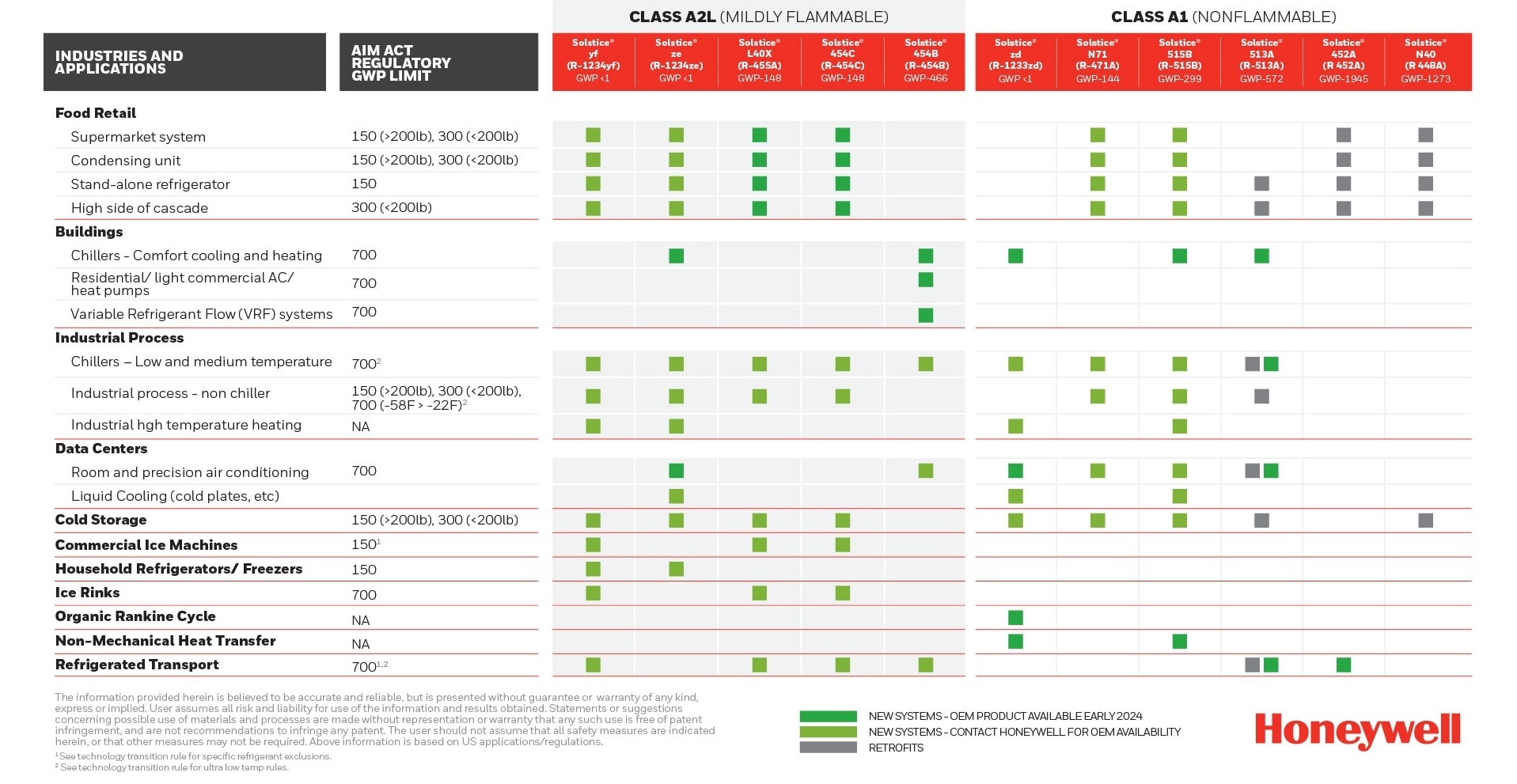Solstice® A2L Refrigerants - Commercial Refrigeration and HVAC Systems
Given the market awareness on safe usage, reliability, performance and lower cost of ownership, the acceptance of A2L refrigerants has grown multifold in the recent years for supermarkets, industrial processes, and residential and commercial buildings. Reach out to a Honeywell Refrigerant expert to learn which A2L refrigerant is right for your HVAC or commercial refrigeration system.
Reach out to a Honeywell Refrigerant expert to learn which A2L refrigerant is right for your application.
A2L refrigerants are sustainable and energy efficient replacements for high-GWP HFCs
The HVACR industry is constantly under pressure to transition to lower Global Warming Potential (GWP) refrigerants for adhering to environmental regulations and to meet their sustainability goals. Honeywell has invested more than one billion dollars in research, development, and new capacity for its Solstice® technology, having anticipated the need for low and ultra-low GWP solutions to combat climate change more than a decade ago.

Industry endorsed
A2l refrigerant transition
Industry organizations such as AHRI have endorsed A2L refrigerants to be acceptable for use in residential and commercial systems with the addition of mitigation measures. A2L refrigerants are significantly lower in flammability than A3 refrigerants. They require much more energy to ignite and require high concentrations in air to become combustible. A2Ls also have lower combustion energy.

Operationally efficient
Low GWP alternative
For companies looking for a cost-effective option, HFO-based A2L refrigerants are an excellent choice. They offer a GWP saving of up to 99.9% compared to HFCs and require minimum system/equipment redesign. Honeywell’s A2L refrigerants are designed to mimic the refrigerants they are replacing by matching capacity and operating parameters, while reducing the engineering effort.

It gets easier with Honeywell
Honeywell has vast domain expertise with a wide installed base of A2L refrigerants dating back more than a decade. Our refrigerants team is here to provide technical support at every stage in the installation and maintenance process.
Customer success stories with Solstice® A2L refrigerants
Keyter commercializes first-ever scroll chiller using Solstice® ze - Honeywell’s ultra-low GWP A2L refrigerant
“As an Andalusian-based organization, we are located in one of the hottest areas of Europe, which enables us to test our machines under extreme circumstances. Honeywell’s Solstice ze technology surpassed performance expectations and its environmental benefits align with global requirements and our mission to preserve the planet, making it the ideal solution”
Francisco Raya, Sales Director, Keyter
Solstice® ze, Honeywell’s ultra-low GWP A2L refrigerant, powers new cooling system at the Eiffel Tower
"The cooling system introduced by Honeywell, ALM Froid and AF Energy provides a unique blend of sustainability, safety, energy efficiency, durability and low maintenance"
Fabrice Fevai, Ascent Department Manager, Société d'Exploitation de la Tour Eiffel (SETE)
New French supermarket, E.Leclerc in Moissac, Selects Low GWP Solstice® L40X - an A2L Refrigerant for cold storage
“We intended to find an alternative refrigerant with high performance that is compatible with our existing infrastructure and keeps us in compliance with the recent legislation put in place”
Régis Plet, Technical Manager for E.Leclerc, Moissac.
MD Discount Store Becomes First Supermarket In Italy To Use Honeywell Solstice® L40X (R-455A)
“We are now engaging with Honeywell to further our work in this area and implement Solstice L40X in our new San Giovanni in Persiceto store, which is projected to support a lifetime cost savings of approximately €260,000 and 25% lower lifetime emissions compared with carbon dioxide for that store alone.”*
Michele Aiello, Technical Director, MD
Heatcraft Developing Refrigeration Equipment With Energy-Efficient Honeywell Solstice® L40X Refrigerant
“Trusted, low-GWP, energy-efficient refrigerants such as Honeywell Solstice® L40X is exactly the type of solution we look for when creating new technologies that meet our customer’s needs and regulatory requirements.”
Bob Landi, vice president and general manager, Heatcraft Refrigeration Products
Contact Us
FAQs
A2l’s are a class or refrigerants in which some can mimic the performance of refrigerants with significantly higher GWP values. The similarity to the refrigerants they are replacing requires little in the way of equipment re-design. The industry is switching to A2L refrigerants to reduce environmental impact and comply with stricter regulations on greenhouse gas emissions. HFO-based A2L refrigerants have a significantly lower global warming potential (GWP) compared to traditional refrigerants, making them a more sustainable choice. This transition helps in mitigating climate change while meeting international standards such as those set by the Kigali Amendment to the Montreal Protocol.
Charging A2L refrigerants involves using proper equipment and following manufacturer safety guidelines to avoid ignition sources. The process is similar to charging other refrigerants. Technicians must be trained in handling mildly flammable substances and follow manufacturer instructions closely.
No, mixing A2L (or any) refrigerants with other refrigerants is not recommended. Each refrigerant has specific chemical properties and pressure requirements. Mixing can result in unpredictable behavior, reduced efficiency, safety hazards, and potential equipment damage.
If A2L refrigerant leaks, it can disperse into the air, posing mild flammability risks. Proper ventilation and leak detection systems are crucial to mitigate these risks. Immediate response and repair by trained personnel are necessary to ensure safety and compliance with regulations.
Requirements for A2L refrigerants mitigation measures based upon the refrigerant charge. These measures are based on ASHRAE 15 and UL safety standards and may include ventilation, leak detection, and isolation. Equipment must be designed to handle mildly flammable substances, and technicians must be trained in safe handling and emergency response procedures.
Transporting A2L refrigerants requires compliance with regulations for flammable materials. They must be securely stored in approved containers, with proper labeling and documentation. Transporters should follow safety guidelines to prevent leaks and ensure safe handling.
There are DOT special permits available that allow for limited shipment of A2Ls in service trucks.
The allowance of A2L refrigerants varies by state, with regulations continually evolving. Checking state-specific guidelines and local building codes is essential. States with progressive environmental policies are more likely to permit A2L refrigerants. Please refer to the AHRI building code map for details - https://www.ahrinet.org/a2l-refrigerant-building-code-map
LFL (Lower Flammability Limit) is the minimum concentration of a gas or vapor in the air that makes the gas capable of igniting. It is crucial for assessing the safety of A2L refrigerants, as it helps determine safe handling practices, charge limits, and the necessary precautions to prevent ignition.
Yes, there is potential for ignition during the installation or service of A2L refrigerants due to their mild flammability. Proper safety measures, including avoiding open flames and using spark-proof tools, are essential to mitigate this risk.
Active mitigation refers to systems and strategies designed to detect and respond to refrigerant leaks. For A2L refrigerants, this may include ventilation, leak detection sensors, and automatic shutdown mechanisms to prevent the accumulation of flammable concentrations.
Yes, servicing systems with A2L refrigerants may require spark-proof tools and equipment rated for flammable gases. This ensures safety by minimizing the risk of ignition during maintenance and repair activities.
No, A2L refrigerants should not be used in systems designed for A1 refrigerants. A1 systems are not equipped to handle the flammability risks associated with A2L refrigerants, leading to safety hazards and potential system failures.
You can top off an A2L system if the refrigerant type and specifications match exactly. However, any contamination or mixture with other refrigerants requires a complete removal and replacement to maintain system integrity and safety.
Installing an A2L system requires additional safety measures, including enhanced ventilation, leak detection systems, and the use of non-sparking tools. Technicians must also be trained in handling mildly flammable refrigerants, unlike with A1 systems.
No, A2L refrigerants should not be mixed with other refrigerants in a recovery cylinder. Mixing can create safety hazards, complicate recycling, and lead to regulatory non-compliance. Dedicated cylinders for each type of refrigerant are necessary.
Systems operating with A2L refrigerants are typically labeled with specific markings indicating their use of mildly flammable substances. These labels include the refrigerant type and flammability classification, and red striping to aid in proper identification and handling.
Yes, charging an A2L system still involves measuring superheat and subcooling to ensure optimal performance.
Yes, A2L refrigerants are covered under EPA Section 608, which regulates the handling, recycling, and disposal of refrigerants to prevent environmental harm and ensure safe practices.
The EPA Certification exam may be updated to include information on A2L refrigerants and their specific handling requirements. Technicians should stay informed about any changes to ensure compliance and safety.
No, the transition to low-GWP refrigerants, including A2L refrigerants, affects a wide range of HVACR systems beyond mini-split units. This includes commercial refrigeration, residential air conditioning, and other applications where traditional refrigerants are used.
To determine if your state allows A2L or A3 equipment, consult local building codes, state regulations, and environmental agencies. Industry associations and manufacturers may also guide state-specific allowances and compliance. Please refer to the AHRI building code map for details. https://www.ahrinet.org/a2l-refrigerant-building-code-map
No, mixing A2L (or any) refrigerants with other refrigerants is not recommended. Each refrigerant has specific chemical properties and pressure requirements. Mixing can result in unpredictable behavior, reduced efficiency, safety hazards, and potential equipment damage.
Several manufacturers, including major HVACR companies like Carrier, and Mitsubishi, have announced their refrigerant choices, often favoring low-GWP R-454B for their products. Check manufacturer announcements for specific details.
Yes, Honeywell provides training programs, resources, and certifications to educate HVACR professionals on handling A2L refrigerants safely. This includes workshops, online courses, and technical support.
While not always mandatory, obtaining a special Low GWP Safety Certification is highly recommended for handling A2L refrigerants. It ensures technicians are knowledgeable about the specific safety protocols and handling practices required for these mildly flammable substances.
Yes, it matters which A2L refrigerant is used, as each has unique properties and performance characteristics as well as specific charge limits based on the refrigerant’s LFL. Selecting the correct refrigerant ensures system compatibility, efficiency, and safety, adhering to manufacturer recommendations and regulatory requirements.
Using A2L refrigerants in equipment manufactured for A1 refrigerants is not allowed. In some cases, piping and other valves may be used. A professional assessment is necessary for safe implementation.
Charge limits for A2L refrigerants vary based on application, system design, and safety standards. These limits are set to minimize flammability risks and ensure safe operation. Refer to industry guidelines and manufacturer specifications for exact limits.
A2L refrigerants are part of the broader move towards low-GWP solutions, likely to remain relevant as regulations favor environmentally friendly options. While future changes are possible, the current trend supports the ongoing use of A2L refrigerants.
Natural refrigerants like CO2 and R290 have their challenges, including high pressure and flammability, respectively. A2L refrigerants offer a balanced solution with lower GWP and manageable safety risks, making them more suitable for a wide range of applications.
A2L refrigerants pose some risks due to their mild flammability, requiring specific handling and adherence to safety protocols. However, with proper training and equipment, they can be safely managed. The lower flammability rating compared to A2 and A3 refrigerants reduces the risk. Their lower toxicity compared to other refrigerants makes them relatively safer in terms of health risks.
*Based on data input from MD and specific analyses using Honeywell’s Eco-Efficiency model


